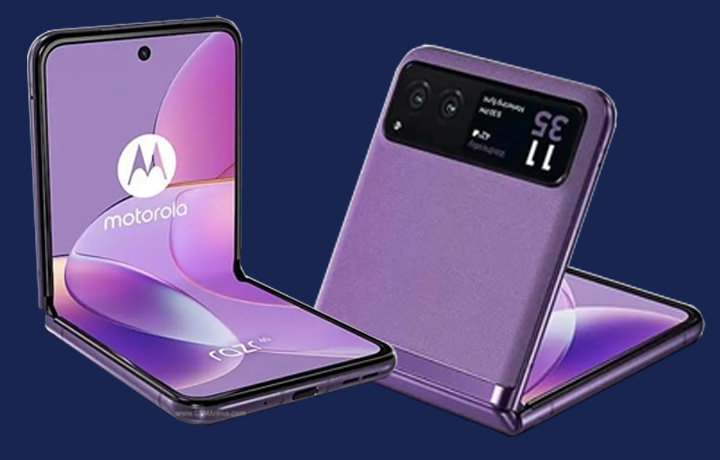Moto Razr 40 Review: A Solid Flip Phone Alternative
With Samsung’s new Galaxy Z5 series making headlines, foldable phones are undoubtedly the talk of the town. But fear not, as we’ve got an exciting alternative for you – the Moto Razr 40.
It may not boast the latest and greatest chipset or an edge-to-edge cover screen, but it does come with an attractive price tag, making it an appealing option for those looking for a flip phone experience without breaking the bank. In this full review, we’ll dive deep into the Moto Razr 40 and see what it brings to the table.
- Moto Razer 40 Ultra Review: Unfolding Innovation and Style
- Unleash the Full Potential of Your Samsung Galaxy S23 Ultra: Masterful Tips and Tricks for Ultimate Performance and Innovation!
Design and Build Quality:
The Moto Razr 40 follows the compact design philosophy of other flip-style phones, utilizing foldable screen technology to hide a typical-sized smartphone within a clamshell form factor. Its design is strikingly similar to the premium Razr 40 Ultra, which has already received our recommendation.
The Razr 40 boasts a grippy vegan leather backing and shares the same aluminum frame and stainless steel teardrop hinge as the Ultra. The hinge allows the phone to fold completely flat without any gaps, and it can stay open at various angles, adding to the overall convenience. Additionally, the device is protected with Gorilla Glass fixes and boasts an IP52 rating for Ingress Protection, just like the Ultra.
Cover Screen:
One of the most noticeable differences in design, when compared to the Razr 40 Ultra or Galaxy Z Flip 5, is the external screen. The Razr 40 features a small 1.5-inch OLED screen with a pixel density of 282 PPI and a 60Hz refresh rate.
While it may not be as cutting-edge as the larger cover screens on the market, it serves well for displaying notifications, adjusting quick settings, accessing widgets, and even acting as a viewfinder for selfies using the main cameras.
Display Quality:
The Moto Razr 40’s inner display is a 6.9-inch foldable LTPS OLED with a 1080p resolution and a 144Hz refresh rate. While it falls slightly short of the Ultra’s 165Hz refresh rate, the difference is hardly noticeable in regular usage, as both devices tend to max out at 120Hz, except for benchmarks or certain games.
The display offers flagship-grade maximum brightness, sharp content, support for 10-bit color, and HDR10+ video. While there’s a crease where the screen folds, it’s not very noticeable unless you actively seek it out.
Audio and Biometrics:
The Razr 40 features a pair of stereo speakers with excellent loudness, clear vocals, and even some bass. The side-mounted fingerprint reader offers quick and responsive biometric security. In terms of storage, the phone comes in two variants: 128GB and 256GB, but sadly, it does not support microSD expansion.
Software and Interface:
Running on Android 13, the Moto Razr 40 provides a near-stock Android experience with some Moto customizations. These Moto features, organized within the Moto app, include gestures, customization options, and dynamic wallpapers that animate when you open and close the phone.
Certain apps also split their user interface when the phone is half-folded, primarily for keyboard or camera purposes. Motorola promises three major OS updates for the Razr 40, ensuring it stays up-to-date with the latest software.
Performance:
Under the hood, the Moto Razr 40 packs a Snapdragon 7 Gen 1 chipset, which may not be the latest and greatest but handles regular tasks smoothly. However, it falls behind the Snapdragon 8 Gen 2 of the Galaxy Z Flip 5 or even the older Snapdragon 8 Plus Gen 1 inside the Razr 40 Ultra. While the Razr 40 performs well for everyday tasks, it may not be suitable for heavy gaming due to its underpowered GPU.
Battery Life and Charging:
With a 4,400mAh battery, the Razr 40 boasts a respectable endurance rating of 85 hours, thanks to its power-efficient OLED display. The phone supports 30-watt charging and provides decent charging speeds, reaching 57% in just 30 minutes. It also supports wireless charging, adding to its convenience.
Camera Performance:
The Moto Razr 40 comes equipped with a 64-megapixel main camera and a 13-megapixel ultra-wide camera. Pixel-binning reduces the main camera’s photos to 16 megapixels by default, producing images with low noise, realistic colors, and adequate dynamic range.
While the detail level may not be as high as some competitors, it strikes a good balance between sharpness and softness. The main camera’s portrait mode offers excellent subject separation, pleasing blur, and decent exposure, but the level of detail may leave some room for improvement.
In low-light conditions, the Razr 40 employs night vision processing to produce likable, detailed, and well-exposed photos. The ultra-wide camera captures above-average photos, especially in the center, and can be used for macro shots of close-up subjects.
Selfies taken with the 32-megapixel front-facing camera deliver excellent detail, low noise, and vibrant colors, making them stand out as a strong point of the device.
- Shop On Amazon Using Our Links To Support Us:
- Amazon under $25:
- Amazon best sellers:
- Amazon most gifted:
Verdict:
The Motorola Razr 40 is undoubtedly a solid flip phone offering, showcasing exceptional folding mechanics and design, similar to its pricier counterpart, the Razr 40 Ultra. While it may lack a large cover screen or a top-of-the-line chipset, it presents an enticing option for those seeking a reliable flip phone experience at a more affordable price point.
If you’re willing to spend a bit more, the Galaxy Z Flip 4 could be a worthy alternative, offering a powerful chipset while being relatively comparable to the Moto Razr 40 price-wise.
In the end, the Moto Razr 40 may not be perfect, but it certainly holds its own as a competitive alternative to the top flagship models out there. Whether you prioritize design and build quality or are intrigued by the nostalgic flip phone experience, the Moto Razr 40 is well worth considering.










